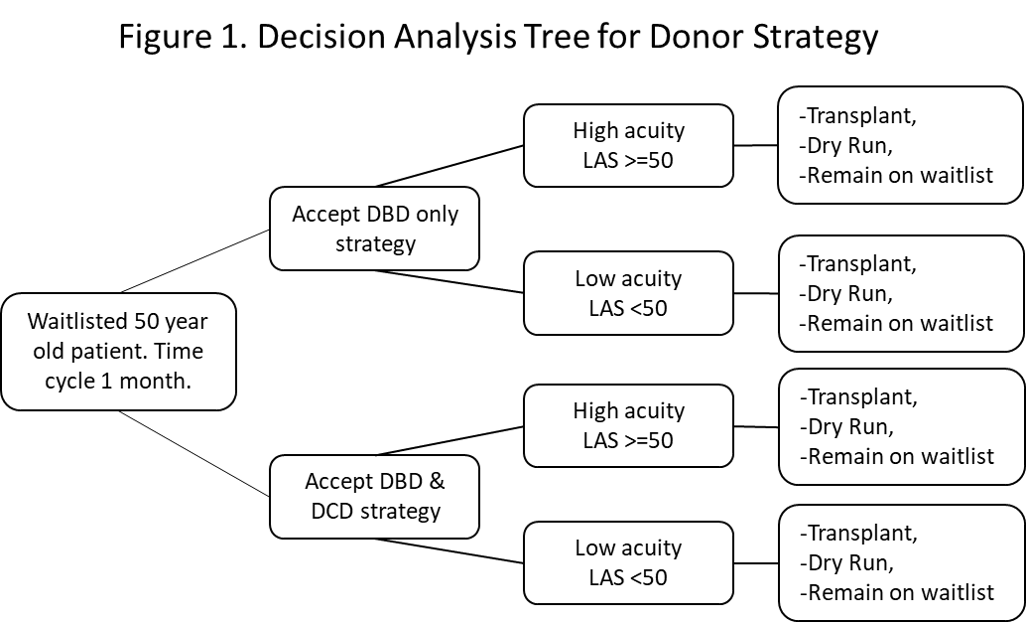Improving Access to Lung Transplant through Donor Strategy: A Decision Analysis
Cleveland Clinic, Cleveland, OH
Meeting: 2019 American Transplant Congress
Abstract number: 474
Keywords: Allocation, Donation, Lung transplantation
Session Information
Session Name: Concurrent Session: Non-Organ Specific: Economics & Ethics
Session Type: Concurrent Session
Date: Tuesday, June 4, 2019
Session Time: 2:30pm-4:00pm
 Presentation Time: 2:42pm-2:54pm
Presentation Time: 2:42pm-2:54pm
Location: Room 309
*Purpose: The use of Donation after Cardiac Death (DCD) donors in addition to Donation after Brain Death (DBD) donors may increase patient access to lung transplant. However only 31% of lung transplant centers in the United States have utilized DCD donors, due in part to the increased risk of ‘dry runs’ where donor lung procurement is unsuccessful and therefore a potential resource cost to a transplant center. We propose a decision analysis tree and hypothesize a strategy using DCD and DBDs as compared to DBD alone is an effective strategy to increase access to transplant.
*Methods: A decision analysis model was developed using TreeAge Pro 2018, R1.1. Data was obtained through a systematic review of MEDLINE for all reports on DCD and DBD in lung transplantation. Analysis was from the viewpoint of a transplant center with a hypothetical 50 year old male patient with pulmonary fibrosis waitlisted for lung transplant for one month. Low clinical acuity was a Lung Allocation Score (LAS) less than 50 and high acuity was an LAS greater than or equal to 50. A high acuity patient has a greater probability of being transplanted, and an increased risk of both waitlist and post-transplant death when compared to a low acuity patient. The outcomes for each strategy were transplant, dry run, or remain on the waitlist. One way sensitivity analysis was performed to test the model strength based on variations in the range of values reported in the literature. The cost per additional transplant was explored relative to a transplant center’s willingness to pay for an additional transplant and the center’s willingness to accept the risk of a dry run. The estimated dry run rate for a DBD was 20% and for a DCD 40%. Probabilistic sensitivity analysis was performed to assess the robustness of the results to changes within the model and its variables.
*Results: A strategy using both DCD and DBD was favored over a strategy using DBD alone, even though there is a higher rate of dry runs with DCD organs. The expected value was 0.21 for the DBD only strategy, and 0.23 for the DBD and DCD strategy. One way sensitivity analysis showed that the DCD and DBD strategy was dominant across the range of probabilities for dry runs and DCD donors.
*Conclusions: A strategy using DCD and DBD donors can improve access to lung transplant. This strategy remained dominant across probabilities of dry runs and DCD donors tested. Further work is needed in assessing center level implementation strategies for increasing the use of DCD donors.
To cite this abstract in AMA style:
Tsuang W, Udeh B. Improving Access to Lung Transplant through Donor Strategy: A Decision Analysis [abstract]. Am J Transplant. 2019; 19 (suppl 3). https://atcmeetingabstracts.com/abstract/improving-access-to-lung-transplant-through-donor-strategy-a-decision-analysis/. Accessed December 16, 2025.« Back to 2019 American Transplant Congress

